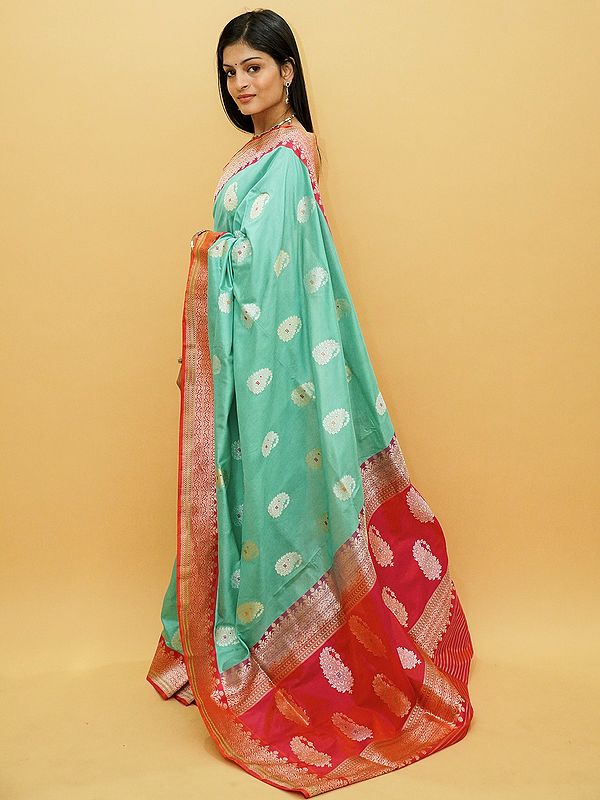Explore the Enchanting Allure of Banarasi Saree Motifs
Banarasi sarees, renowned for their timeless elegance and luxurious appeal, have captured the hearts of fashion enthusiasts for centuries. Originating from the culturally rich city of Varanasi, also known as Banaras, these sarees boast intricate motifs and an exquisite luster that add a touch of opulence to any wardrobe. In this article, we delve into the captivating world of Banarasi saree motifs, uncovering their significance, symbolism, and the artistry behind their creation.
1. The Rich Heritage of Banarasi Sarees
Before we embark on a journey into the realm of Banarasi saree motifs, let's take a moment to appreciate the rich heritage they encapsulate. Dating back to the Mughal era, these sarees have been a symbol of regal grace and unparalleled craftsmanship. The skilled weavers of Varanasi carefully pass down their weaving techniques from one generation to the next, preserving the essence of this traditional art form.
2. The Essence of Banarasi Saree Motifs
Banarasi saree motifs are an embodiment of artistic brilliance, capturing a myriad of inspirations from nature, mythology, and historical tales. Each motif tells a unique story, infusing the saree with cultural depth and emotional resonance. The most common motifs include:
2.1. The Peacock Motif
The peacock motif is a recurrent theme in Banarasi sarees, symbolizing beauty, love, and immortality. With its striking plumage and graceful demeanor, the peacock is associated with goddess Saraswati and represents wisdom and learning.
2.2. The Lotus Motif
The lotus, a symbol of purity and spiritual awakening, finds its way into Banarasi saree designs. This exquisite flower holds immense cultural and religious significance in Indian traditions, embodying purity rising above the muddy waters of life.
2.3. The Paisley Motif
Popularly known as the "mango" motif, the paisley design graces many Banarasi sarees. It symbolizes fertility, prosperity, and growth, making it a beloved choice for auspicious occasions.
3. The Craftsmanship Behind Banarasi Saree Motifs
Creating these mesmerizing saree motifs requires the skillful hands of master weavers who meticulously weave the intricate patterns into the fabric. Traditionally, real gold and silver threads were used to accentuate the motifs, adding a radiant gleam to the sarees. While modern versions may utilize other materials, the artistry remains unparalleled.
4. Banarasi Saree Motifs in Contemporary Fashion
While Banarasi sarees have deep roots in tradition, they have gracefully adapted to contemporary fashion trends. Today, these sarees are not only popular among brides and at weddings but also make a statement at various festivities and high-end events. Renowned fashion designers have embraced the allure of Banarasi saree motifs, incorporating them into modern silhouettes to appeal to a broader audience.
5. Caring for Banarasi Sarees
To preserve the everlasting beauty of Banarasi saree motifs, proper care is essential. Here are some tips to ensure their longevity:
- Dry Clean Only: Avoid machine wash and opt for professional dry cleaning to prevent any damage to the delicate motifs.
- Storage: Store the saree in a cool, dry place, away from direct sunlight, to prevent discoloration.
- Avoid Moisture: Keep the saree away from damp environments to prevent any mold or mildew growth.
- Handle with Care: While draping and handling the saree, be gentle to avoid any accidental tears or pulls.
6. The Timeless Allure of Banarasi Saree Motifs
In conclusion, Banarasi saree motifs continue to be a symbol of grace, heritage, and artistry. Their timeless allure has transcended generations and borders, making them a cherished possession for women who seek elegance and sophistication in their attire. The intricate motifs and opulent luster of Banarasi sarees are a testament to the unparalleled craftsmanship and cultural legacy of Varanasi, India. Whether it's a grand celebration or an intimate gathering, draping a Banarasi saree adorned with resplendent motifs is sure to leave an everlasting impression.










Comments
Post a Comment